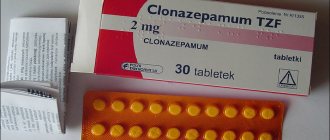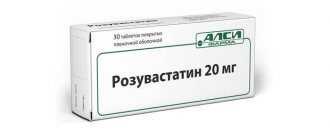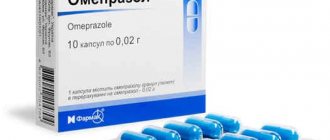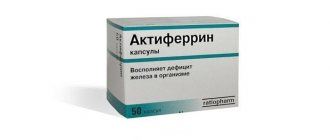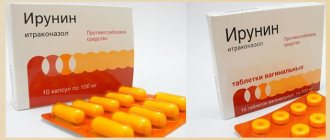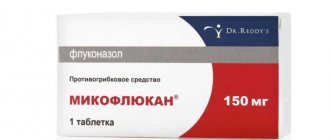Loperamide is a rapid-acting antidiarrheal drug that is taken orally immediately after the onset of loose stools. It does not affect the etiological cause of diarrhea, it is a symptomatic remedy that slows down intestinal motility, and therefore cannot be considered as the main treatment (see diarrhea tablets).
Pharmacological group: Symptomatic remedy for the treatment of diarrhea.
Release form and composition
Dosage form - capsules: cylindrical with hemispherical ends, hard, gelatinous, white or white with a yellowish tint; contents – white or white granules with a yellowish tint (in a cardboard box there are 1–2 strip packs of 10 capsules each and instructions for use of Loperamide hydrochloride).
Composition of 1 capsule:
- active substance: loperamide hydrochloride – 2 mg;
- auxiliary components: magnesium stearate, corn starch, lactose monohydrate;
- capsule shell composition: gelatin, sodium lauryl sulfate, glycerin, propyl parahydroxybenzoate E 216, methyl parahydroxybenzoate E 218, titanium dioxide E 171, purified water.
Indications for use of Loperamide
The instructions for use of Loperamide indicate that the drug is not an etiological drug, i.e. is not able to suppress the growth of pathogenic intestinal flora.
Symptomatic treatment of diarrhea (chronic and acute) of various origins:
- infectious (as an adjuvant)
- allergic
- emotional
- radiation (after radiation therapy)
- medicinal (while taking drug treatment, for example, antibiotic therapy)
- functional, associated with changes in diet, type and composition of food
- against the background of metabolic and absorption disorders.
It is also prescribed for the correction of stool in patients with ileostomy (surgical intervention when a loop of the ileum is brought out onto the abdominal wall to form a fistula) - to reduce the frequency and quantity of stool, as well as a denser consistency of stool.
Pharmacological properties
Pharmacodynamics
Loperamide is a peripheral opioid receptor agonist. Its antagonist is naloxone.
The mechanism of action of loperamide hydrochloride is due to the ability to suppress the release of acetylcholine and prostaglandins, reduce propulsive peristalsis, reduce the transit time of contents through the intestines, and enhance the ability of the intestinal wall to absorb fluid.
By increasing the tone of the anal sphincter, the drug reduces the urge to defecate and fecal incontinence.
Loperamide is highly specific for the intestinal wall. Reaches systemic circulation to a limited extent. Practically does not penetrate the blood-brain barrier.
The maximum dose of loperamide hydrochloride that exhibits an antidiarrheal effect is well below the threshold for central action.
Pharmacokinetics
Once in the intestine, most of loperamide hydrochloride is absorbed. The drug undergoes extensive metabolism during its first passage through the liver, so systemic bioavailability is about 0.3% and plasma concentrations are very low.
Studies in rats have shown that loperamide has high affinity for the intestinal wall and binds predominantly to receptors in the longitudinal muscle layer. According to preclinical data, loperamide is a substrate of P-glycoprotein.
Approximately 95% of the dose is bound to plasma proteins (mainly albumin). Loperamide does not penetrate the BBB (blood-brain barrier).
Loperamide hydrochloride is almost completely metabolized in the liver by conjugation and then excreted in the bile. The main metabolic pathway is oxidative N-demethylation with the participation mainly of the CYP3A4 and CYP2C8 isoenzymes.
Loperamide and its metabolites are excreted mainly in the feces. The half-life is 9–14 hours.
The pharmacokinetic parameters of loperamide have not been studied in children. It is expected that the characteristics of loperamide, including interactions with other drugs, will be similar to those in adults.
Contraindications
- diarrhea with blood in the stool and high fever;
- acute ulcerative colitis;
- intestinal obstruction;
- conditions in which suppression of peristalsis is contraindicated;
- diverticulosis;
- pseudomembranous enterocolitis (diarrhea caused by taking antibiotics);
- acute dysentery and other gastrointestinal tract infections (including those caused by Campylobacter spp., Salmonella spp. and Shigella spp.);
- rare congenital galactose intolerance, lactase deficiency, glucose/galactose malabsorption syndrome;
- children under 6 years of age;
- I trimester of pregnancy;
- lactation period;
- hypersensitivity to any component of the drug.
Loperamide hydrochloride capsules should be used with caution in case of liver failure, in the second and third trimesters of pregnancy.
Loperamide hydrochloride, instructions for use: method and dosage
Loperamide hydrochloride capsules are taken orally, swallowed whole and washed down with water.
Recommended doses for adults:
- acute diarrhea: first dose – 2 capsules, then – 1 capsule after each bowel movement in case of loose stools;
- chronic diarrhea: initial dose - 2 capsules, then the dose is selected so that the frequency of stool is 1-2 times a day, this requires taking Loperamide hydrochloride 1-6 capsules per day.
The maximum daily dose for adults for acute and chronic diarrhea is 8 capsules.
Recommended doses of Loperamide hydrochloride for children 6–17 years of age:
- acute diarrhea: initial dose – 1 capsule, then – 1 capsule after each bowel movement in case of loose stools;
- chronic diarrhea: 1 capsule 1 time per day.
The maximum dose for children with acute and chronic diarrhea is calculated by body weight: 6 mg (3 capsules) per 20 kg of body weight, but it should not exceed 16 mg (8 capsules) per day.
Therapy is terminated after the appearance of normal stool or in the absence of stool for more than 12 hours.
If acute diarrhea does not improve after 48 hours, you should discontinue Loperamide hydrochloride and consult a doctor.
An important condition of treatment, especially for children, is the replenishment of fluids and electrolytes.
Analogs of Loperamide
Loperamide-acri, Lopedium, Diara, Imodium, Loperamide-stad, Vero-loperamide, Loflatin, Stoperan.
| Lopedium 30-60 rub. | Diara 90 rub. | Imodium 160-230 rub. | Stoperan | Loflatin |
Author:
Sabuk Tatyana Leonidovna hygienist, epidemiologist
Side effects
Adverse reactions according to the frequency of development are classified as follows: very often - > 10%, often - from > 1% to < 10%, infrequently - from > 0.1% to < 1%, rarely - from > 0.01% to < 0.1%, very rarely - <0.01%, including isolated cases.
Side effects observed in both acute and chronic diarrhea:
- from the immune system: rarely - hypersensitivity reactions, anaphylactic reactions (including anaphylactic shock);
- from the nervous system: often – headache, dizziness; infrequently - drowsiness; rarely - loss of consciousness, stupor, depression of consciousness, loss of coordination, increased muscle tone;
- from the organ of vision: rarely – miosis;
- from the gastrointestinal tract: often – flatulence, nausea, constipation; uncommon – dry mouth, discomfort and abdominal pain, vomiting, dyspepsia; rarely - bloating, glossalgia, intestinal obstruction (including paralytic ileus), megacolon (including toxic);
- from the kidneys and urinary system: rarely – urinary retention;
- from the skin and subcutaneous tissues: infrequently - rash; rarely - itching, urticaria, angioedema, bullous rash (including erythema multiforme, toxic epidermal necrolysis, Stevens-Johnson syndrome);
- other: rarely – fatigue.
Overdose
An overdose of loperamide causes urinary retention, intestinal obstruction and depression of the central nervous system (CNS), which is manifested by drowsiness, impaired coordination of movements, stupor, muscle hypertension, miosis, and respiratory depression.
First aid measures (no later than 3 hours after taking an excessive dose of Loperamide hydrochloride): gastric lavage, taking activated charcoal. Further treatment is symptomatic. In case of respiratory depression, artificial ventilation is performed. The antidote for loperamide is naloxone, which has a shorter duration of action than loperamide and may require repeat administration. The patient should be under medical supervision for at least 48 hours to identify possible CNS depression.
special instructions
If constipation, bloating or intestinal obstruction occurs while taking loperamide, the drug should be discontinued immediately.
If patients with acute diarrhea do not improve after 48 hours, stop taking Loperamide hydrochloride and consult a doctor. Additional examination is required to exclude infectious origin of diarrhea.
Treatment with the drug is symptomatic, so it is simultaneously recommended to use etiotropic drugs to eliminate the cause of the disorder.
Diarrhea, especially in children, can cause hypovolemia and decreased electrolytes. As a result, an important aspect of treatment is the replacement of fluids and electrolytes. Diet is recommended.
Patients with acquired immunodeficiency syndrome (AIDS) should stop treatment immediately at the first sign of abdominal bloating. With infectious and bacterial colitis, such patients in some cases may develop toxic expansion of the colon.
Impact on the ability to drive vehicles and complex mechanisms
Loperamide hydrochloride may cause side effects from the central nervous system (including drowsiness and dizziness), so it is recommended to refrain from potentially hazardous activities during treatment.
At what age can a child be given this medicine for diarrhea?
Can Loperamide be given to children and at what age? This drug is contraindicated in children under 2 years of age. If the pediatrician nevertheless prescribed this medicine to the child, then you should strictly follow the dosage indicated by the doctor in order to avoid negative consequences. If your baby is two years old, then there are no contraindications.
Restrictions on the use of the drug arise in the following circumstances:
- stomach ache;
- diarrhea with high fever;
- ulcerative colitis;
- bloody, black, or tarry loose stools;
- allergy to Loperamide.
When a doctor prescribes Loperamide to a child, be sure to tell the specialist about:
- fever;
- mucus in stool;
- liver diseases;
- already taking antibiotics.
Do not take more than the recommended dose of this medicine, otherwise it will cause bad effects. If your child does not have bowel movements for more than 12 hours, the medication should be stopped immediately.
When taking Loperamide, you need to drink plenty of fluids. In this case, it may take about 48 hours of taking Loperamide before the patient’s condition improves. Continue to use this medication as directed and tell your doctor if there is no improvement after 4 days of treatment.
The drug is available in pharmacies without a prescription. For children aged 2 to 5 years, the medicinal powder is diluted in water (5 ml) and given orally. For ages 6 and older, tablets or capsules are recommended.
For children aged 2 to 7 years, the following first day dosage plan is recommended:
- from two to five years: 1 mg 3 times a day (body weight 13-20 kg);
- over six years: 2 mg 2 times a day (body weight 20-30 kg).
Subsequent recommended dosage: After the first day of treatment, it is recommended that previous doses (1 mg per 10 kg body weight) be administered only after loose stools. The daily dose does not exceed the recommended figures for the first day.
Rarely, some children experience side effects when using this medication, which can lead to negative consequences and even death if the cause is not identified in time. Tell the doctor or get medical help right away if your child has the following symptoms after using this medicine:
- signs of an allergic reaction such as hives, itching, blistering or flaking skin with or without fever;
- wheezing;
- chest pain or palpitations;
- constipation;
- bloating;
- black, tarry, or bloody stools.
Drug interactions
It is expected that with the simultaneous use of drugs with similar pharmacological properties, the effect of loperamide hydrochloride may be enhanced, and drugs that enhance gastrointestinal motility may decrease its effect.
Co-administration of quinidine or ritonavir, which are P-glycoprotein inhibitors, increases the plasma concentration of loperamide, used in a single dose of 16 mg, by 2-3 times. When taking the drug at recommended doses, the clinical significance of this interaction is unknown.
With the simultaneous use of loperamide hydrochloride in a single dose of 16 mg and ketoconazole, which is an inhibitor of the CYP3A4 enzyme and P-glycoprotein, a 5-fold increase in the plasma concentration of loperamide was noted, but this was not accompanied by an increase in its pharmacodynamic effects.
With the simultaneous use of loperamide in a single dose of 4 mg and itraconazole, which is an inhibitor of the CYP3A4 enzyme and P-glycoprotein, a 3-4-fold increase in the plasma concentration of loperamide was noted. In the same study, gemfibrozil (a CYP2C8 inhibitor) increased plasma loperamide levels by approximately 2 times. With the simultaneous use of itraconazole and gemfibrozil, the maximum plasma concentrations of loperamide increased by 4 times, and the total plasma exposure increased by 13 times. However, the results of psychomotor tests (digital symbol substitution test and subjective sleepiness test) did not show an increase in the effect of the combination of these substances on the central nervous system.
Loperamide hydrochloride, when used together, increases the plasma content of desmopressin by 3 times (probably due to inhibition of gastrointestinal motility).
Loperamide should not be used in children in combination with drugs that can depress the central nervous system.
Reviews
Reviews about the treatment of diarrhea in children with Loperamide are mostly positive. People note the quick effect and long-lasting effect of the product. Many have managed to cure diarrhea in children caused by overeating, stress, and acclimatization. The drug does not harm the child’s body, is well tolerated and does not provoke unwanted reactions. Also, some used the medicine for disorders of infectious etiology, but as part of complex therapy. In addition, Loperamide is an inexpensive medicine.
Doctors do not advise giving the drug to children unless absolutely necessary, only when the number of bowel movements exceeds 3 times a day and the stool has a liquid consistency. Improper use of Loperamide leads to CNS depression. Doctors insist on preliminary consultation, diagnosis and clarification of the root cause of diarrhea.
